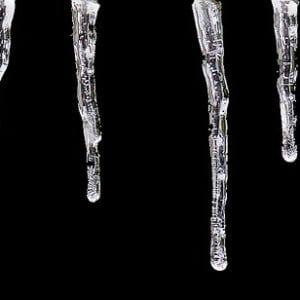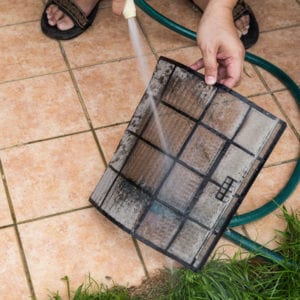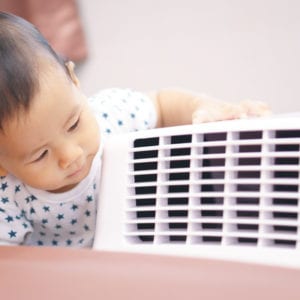Why Do Air Conditioners Freeze? 5 Possible Causes of a Frozen Air Conditioner
A frozen air conditioner? Strange as it sounds, it happens. We answer hundreds of calls for air conditioner repair in Toronto and the GTA each year, and there are always a few homeowners asking how to fix a frozen air conditioner. So, why do air conditioners freeze in the first place, and what can you do about it?
Why Do Air Conditioners Freeze?
In most cases, the cause of a frozen air conditioner has to do with an interruption in the heat transfer process.
The most common type of central air conditioning in Toronto is the split system. Split central air conditioners work by drawing warm air out of the home with the help of a blower fan; the warm air moves through the air ducts until it reaches the evaporator coil. There, a heat transfer takes place. The air is cooled by refrigerant as it passes over the coil, and the refrigerant disperses the heat outside through the outdoor condenser unit.
What does this have to do with air conditioners freezing up? When something prevents this heat transfer from happening, the ice-cold refrigerant can freeze condensation that builds on the evaporator coil.
Left untouched, ice can encase the entire indoor unit and even spread to the outdoor components.
An air conditioner that continues to freeze up or is frozen for an extended time can be severely damaged. If your air conditioner is frozen, we recommend calling for air conditioner repair in Toronto or the GTA as soon as possible.
Possible Causes of a Frozen Air Conditioner
The following are common causes of ice build-up on a split central air conditioner:
- Leak in the refrigerant line causing low pressure
- Poor airflow to the evaporator coil
- Dirt build-up on the evaporator coil
- Low outdoor temperature (16°C/62°F)
- Malfunctioning blower fan
1. Refrigerant Leak
Putting refrigerant under pressure causes its temperature to rise; the opposite occurs when it expands. Air conditioners use this effect to cool the evaporator coil and transfer heat from the warm indoor air to the air outside.
A leak in the refrigerant line (even a very small one) causes pressure to drop. As a result, the refrigerant is forced to expand more, causing the evaporator coils to become colder. This temperature shift may not be evident at first, but if the system continues to lose refrigerant, more and more ice will accumulate on the coils.
If the air conditioner is in good condition overall and has years of useful life left, a qualified heating and cooling technician can fix the problem by repairing the leak and ‘recharge’ the refrigerant. For older units, a refrigerant leak is often caused for replacement.
2. Poor Airflow
A split central air conditioner lowers the home’s temperature by drawing warm air into the ductwork and through the evaporator coils to transfer the heat outside. In the process, moisture from the air builds up on the coils as condensation. The heat absorbed by the refrigerant prevents this moisture from freezing.
But what if warm air can’t get through to the coils? The heat transfer cannot take place if something is obstructing the flow of air. In that case, there is nothing to keep the condensate from turning to ice.
There are many possible reasons for poor airflow to an air conditioner:
- Filters have not been cleaned or replaced in more than three months
- Supply registers blocked by furniture or other objects
- Closed or blocked gates or dampers
- Air ducts clogged with dust or debris
- Air duct leak
The first three are potential causes are things homeowners can investigate themselves. Inspecting air ducts for leaks or obstructions is messier and more difficult.
If you suspect a problem with your air ducts, contact a qualified HVAC technician you trust (not a door-to-door duct cleaning salesperson.)
3. Dirty Evaporator Coils
Few people realize how much dust and debris build up in their central heating and cooling system. Most of it is caught in the air filter or ductwork before it reaches the air conditioner, but dirt can accumulate on the evaporator coils over time.
A layer of dirt between the air and the coils makes it harder for the refrigerant to absorb heat. The result? Condensate begins to freeze on the coils, further limiting heat transfer.
Most homeowners do not have the expertise to inspect or clean the evaporator coils without risking damage to the air conditioner. Call a qualified technician if your central air conditioner requires maintenance.
4. Low Outdoor Temperature
Central air conditioners require a warm ambient temperature to transfer heat outside the home. If the outdoor temperature drops below a certain threshold (usually 16°C or 62°F), the system cannot operate properly, and ice can form on the coils.
Low temperature is not normally a concern in the summer months in Ontario, but the temperature can drop suddenly at night on rare occasions. This is one reason why it’s wise to program the thermostat to shut off the air conditioning at night.
Barring an unseasonably warm September, homeowners should take steps to close the air conditioner come fall.
5. Damaged Blower Fan
The blower fan pulls warm air into the air ducts then re-distributes cool air throughout the home. If the fan or its motor malfunctions, the heat transfer process comes to a standstill, and ice will begin to accumulate on the evaporator coils if the air conditioner continues to run.
My Air Conditioner Is Frozen – What Should I Do?
The most common causes of a frozen air conditioner are heat transfer issues: low pressure due to a refrigerant leak, a lack of warm air reaching the evaporator coil, or low ambient temperature.
If the problem stems from a dirty air filter, blocked vents, or closed dampers, the homeowner can usually resolve it. Other issues, such as a refrigerant leak, dirty evaporator coils, or blower fan malfunction, should be addressed by a professional qualified in air conditioner repair.
Our team is on-call 24 hours a day for air conditioner repair in Toronto and the Greater Toronto Area. View our service area here or click here for a free estimate.










